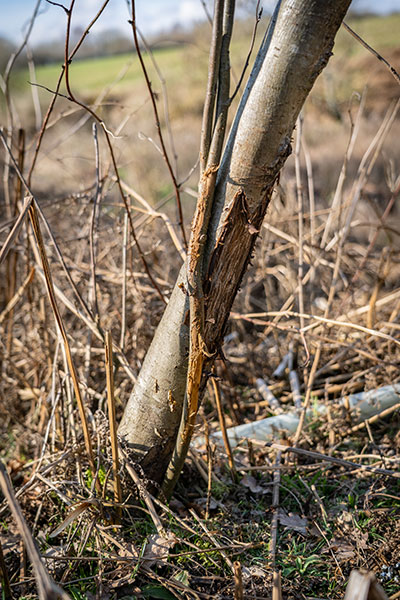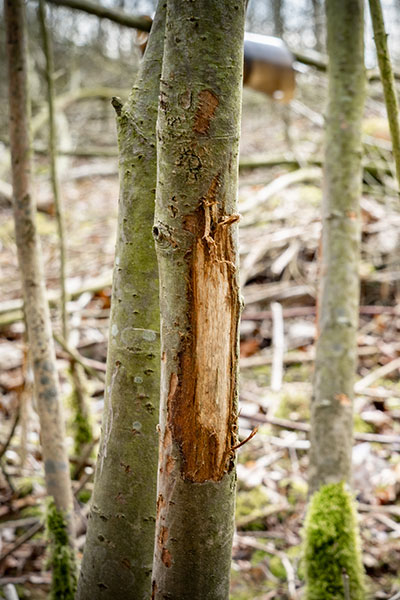The carbon hoof print – deer impact on Britain’s ‘green lungs’
One of the main thrusts of the UK government’s reactions to the climate and biodiversity crises is the drive to plant more trees. The goal is to plant 30,000ha more trees per annum in England and 18,000ha per annum in Scotland by 2024/5 in fact. This is because trees capture carbon and provide habitat for a range of species – both common and rare.
However, this ambitious target to create more woodland AND capture more carbon will only succeed if the trees are able to grow. That means protecting them from animals which eat them – and deer impact on woodland is perhaps the most noteworthy of all.
8,000h – Woodlands with Site of Special Scientific Interest (SSSI) status which are currently in unfavourable or recovering condition due to deer impact. This is likely to represent a fraction of the real picture, according to the Parliamentary Office for Science and Technology.
Deer are one of the main culprits in damaging both newly planted and older trees. And, at the moment, there are more deer in the UK than at any point in history, with an estimated population of around two million.
How do deer impact carbon capture by trees?
By eating young shoots, leaves and ground flora, deer reduce the amount of vegetation that would use CO2 for photosynthesis. The photosynthesis process converts energy captured from sunlight, water (H2O) and carbon dioxide (CO2) into by-product oxygen (O2), which is then released back into the atmosphere, and glucose, a source of chemical energy, stored within the plant and used for its functions.
50% – The decline in woodland bird numbers where deer are present in high densities.
As well as tree planting, there is a drive to create more woodland, and particularly native broadleaved woodland, via natural regeneration. This happens when seedlings are shed into the gaps left by older trees as they die and, making use of the light and lack of canopy, develop into young and then mature trees.
Where these small trees or seedlings are eaten off by deer, other plants become dominant, such as bramble or nettles and so the success of any young trees that do get away is further compromised. So, as you can see, deer impact on woodlands and their important functions can be quite substantial.
Deer can affect the age diversity of a woodland, resulting in a fall in numbers of species, and strip bark off older trees, which kills them.” Paul Wilkinson, chief executive, Nottinghamshire Wildlife Trust.
Natural regeneration is very difficult if deer pressure is high in any woodland.


Do deer affect mature trees?
Deer also have a negative impact on the carbon storage ability of mature trees.
They strip the bark from mature trees with their incisors to uncover the sugars stored beneath and fray it as they clean their antlers. This can result in devaluation of the timber in producing bent or stained stems, making them unfit for use as quality building material or furniture. Hence it is used as firewood, fencing or pulp, products which do not lock up carbon for as long as a building would.
£4.5m – The cost of damage caused by deer to commercial woodlands (Forestry and Land Scotland)
Fraying can also lead to the death of the tree. The rotting and decomposing processes release carbon dioxide into the atmosphere – something we want to minimise.
Achieving harmony
In order to reduce deer damage to woodland and biodiversity, and limit the threat they pose to new woodlands, we must reduce deer numbers to a sustainable level. This means getting numbers to a point where they are in harmony with their habitat.
Deer will eat the understorey and so the coppices, for example, lose their shrub layer. That can be a problem for nightingales and other long-distance migrants, such as willow warblers, chiffchaffs and blackcaps.” Dr Paul Dolman, University of East Anglia .
Controlling deer numbers also reduces the risk of disease, starvation and deer vehicle collisions.
74,000 – The number of road traffic accidents a year involving deer, which kill between 10-20 people (RSPCA).
Training deer managers to carry out ethical and humane culling through our industry-standard qualifications; promoting best practice in deer management; providing opportunities for people to experience deer stalking on our stalking schemes – BASC is leading the way in deer management.
£4.3m p.a. – The cost of deer damage to crops, with the greatest damage on cereal crops in east and south-west England (Defra).
By doing so, we are also helping private woodland owners and government agencies such as Forestry England and Forestry and Land Scotland meet their woodland planting targets and contribute to our target of net zero emissions.
